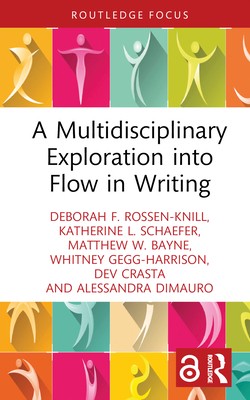
- We will send in 10–14 business days.
- Author: Deborah F Rossen-Knill
- Publisher: Routledge
- ISBN-10: 1032604956
- ISBN-13: 9781032604954
- Format: 14 x 21.6 x 1 cm, kieti viršeliai
- Language: English
- SAVE -10% with code: EXTRA
A Multidisciplinary Exploration Into Flow in Writing (e-book) (used book) | bookbook.eu
Reviews
Description
Offering a multidisciplinary exploration of "flow" and the often-nebulous ways it is conceptualized and operationalized in writing pedagogy, this book addresses a critical gap in Writing Studies.
Bringing together practice-based and scholarly perceptions, this book outlines the key features, definitions and approaches of flow and identifies pedagogical opportunities for classroom instruction. Incorporating perspectives from disciplines including classical rhetoric, composition studies, cognitive science, and linguistics, this book provides a diverse overview of the literature on flow in writing pedagogy. It includes two instructional voice-based and rhetorical-grammar-based activities that outline how to recognize and improve flow in writing. In doing so, the book also provides clear examples of how to create an inclusive writing pedagogy that incorporates sensory and analytical perspectives to help readers and writers experience flow and meet their writing goals.
As an exploration of flow instruction as it currently stands and might stand in the future, this book will be of interest to students and instructors in the field of academic, professional and creative writing studies.
EXTRA 10 % discount with code: EXTRA
The promotion ends in 21d.17:39:31
The discount code is valid when purchasing from 10 €. Discounts do not stack.
- Author: Deborah F Rossen-Knill
- Publisher: Routledge
- ISBN-10: 1032604956
- ISBN-13: 9781032604954
- Format: 14 x 21.6 x 1 cm, kieti viršeliai
- Language: English English
Offering a multidisciplinary exploration of "flow" and the often-nebulous ways it is conceptualized and operationalized in writing pedagogy, this book addresses a critical gap in Writing Studies.
Bringing together practice-based and scholarly perceptions, this book outlines the key features, definitions and approaches of flow and identifies pedagogical opportunities for classroom instruction. Incorporating perspectives from disciplines including classical rhetoric, composition studies, cognitive science, and linguistics, this book provides a diverse overview of the literature on flow in writing pedagogy. It includes two instructional voice-based and rhetorical-grammar-based activities that outline how to recognize and improve flow in writing. In doing so, the book also provides clear examples of how to create an inclusive writing pedagogy that incorporates sensory and analytical perspectives to help readers and writers experience flow and meet their writing goals.
As an exploration of flow instruction as it currently stands and might stand in the future, this book will be of interest to students and instructors in the field of academic, professional and creative writing studies.


Reviews